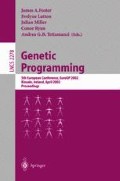Abstract
This study examines the potential of grammatical evolution to construct a linear classifier to predict whether a firm’s corporate strategy will increase or decrease shareholder wealth. Shareholder wealth is measured using a relative fitness criterion, the change in a firm’s marketvalue- added ranking in the Stern-Stewart Performance 1000 list, over a four year period, 1992-1996. Model inputs and structure are selected by means of grammatical evolution. The best classifier correctly categorised the direction of performance ranking change in 66.38% of the firms in the training set and 65% in the out-of-sample validation set providing support for a hypothesis that changes in corporate strategy are linked to changes in corporate performance.
Access this chapter
Tax calculation will be finalised at checkout
Purchases are for personal use only
Preview
Unable to display preview. Download preview PDF.
References
Altman, Edward I. (1993). Corporate Financial Distress and Bankruptcy, New York: John Wiley and Sons Inc.
Bauer, R. (1994). GeneticA lgorithms and Investment Strategies, New York: John Wiley & Sons.
Bowman, E. and Helfat, C. (2001). Does Corporate Strategy Matter?,Strategic Management Journal, 22:1–23.
Brabazon, T., Glintchak E., Matthews R. (2001). Modelling the relationship between strategy and corporate performance using a hybrid GA/NN model, in Proceedings of the SEAG Annual Conference, 10 September 2001, Oxford.
Elfring, T. and Volberda, H. (1996). Schools of Thought in Strategic Management: Fragmentation, Integrating or Synthesis?, in Elfring, T. Jensen, H. and Money, A. (eds), Theory Building in the Business Sciences pp. 11–47, Copenhagen, Copenhagen Business School Press.
Hair, Joseph F., Anderson, Rolph E., Tatham, Ronald L. and Black, William C. (1998). Multivariate Data Analysis, Upper Saddle River, Prentice Hall.
Klemz, B. (1999). Using genetic algorithms to assess the impact of pricing activity timing, Omega, 27:363–372.
Koza, J. (1992). GeneticProgramming. MIT Press.
Levitt, B. and March J. (1988). Organizational Learning, Annual Review of Sociology, 14:319–340.
McKelvey, B. (1999). Avoiding Complexity Catastrophe in Coevolutionary Pockets: Strategies for Rugged Landscapes, Organization Science, 10(3):294–321.
Mintzberg, H. (1990). Strategy Formation: Schools of Thought., in Frederickson, J. (ed.), Perspectives on Strategic Management, pp. 107–108, New York.
Morris, R. (1997). Early Warning Indicators of Corporate Failure: A critical review of previous research and further empirical evidence, London: Ashgate Publishing Limited.
Nelson, R. and Winter, S. (1982). An Evolutionary Theory of Economic Change, Cambridge, Massachusetts, Harvard University Press.
O’Neill M. (2001) Automatic Programming in an Arbitrary language: Evolving Programs with Grammatical Evolution. Ph.D. thesis, University of Limerick, 2001.
O’Neill M., Ryan C. (2001) Grammatical Evolution. IEEE Trans. Evolutionary Computation, Vol. 5 No. 4, August 2001.
O’Neill, M., Brabazon, T., Ryan, C. and Collins J.(2001). Evolving Market Index Trading Rules Using Grammatical Evolution, In LNCS 2037: Applications of Evolutionary Computing, pp. 343–35, Springer-Verlag.
Pendharkar, P. (2001). An empirical study of design and testing of hybrid evolutionary-neural approach for classification, Omega, 29:361–374.
Porter, M. (1985). Competitive Advantage:Creating and Sustaining Superior Performance, New York, The Free Press.
Porter, M. (1996). What is Strategy?, Harvard Business Review, Nov-Dec, 61-78.
Ryan C., Collins J.J., O’Neill M. (1998). Grammatical Evolution: Evolving Programs for an Arbitrary Language. LNCS 1391, Proc. of the First European Workshop on GeneticPr ogramming, pp. 83–95. Springer-Verlag.
St. John, C., Balakrishnan, N. and Fiet, O. J. (2000). Modelling the relationship between corporate strategy and wealth creation using neural networks, Computers and operations research, 27:1077–1092.
Varetto, F. (1998). Genetic algorithms in the analysis of insolvency risk, Journal of Banking and Finance, 22(10):1421–1439.
Author information
Authors and Affiliations
Editor information
Editors and Affiliations
Rights and permissions
Copyright information
© 2002 Springer-Verlag Berlin Heidelberg
About this paper
Cite this paper
Brabazon, A., O’Neill, M., Ryan, C., Matthews, R. (2002). Evolving Classifiers to Model the Relationship between Strategy and Corporate Performance Using Grammatical Evolution. In: Foster, J.A., Lutton, E., Miller, J., Ryan, C., Tettamanzi, A. (eds) Genetic Programming. EuroGP 2002. Lecture Notes in Computer Science, vol 2278. Springer, Berlin, Heidelberg. https://doi.org/10.1007/3-540-45984-7_10
Download citation
DOI: https://doi.org/10.1007/3-540-45984-7_10
Published:
Publisher Name: Springer, Berlin, Heidelberg
Print ISBN: 978-3-540-43378-1
Online ISBN: 978-3-540-45984-2
eBook Packages: Springer Book Archive

